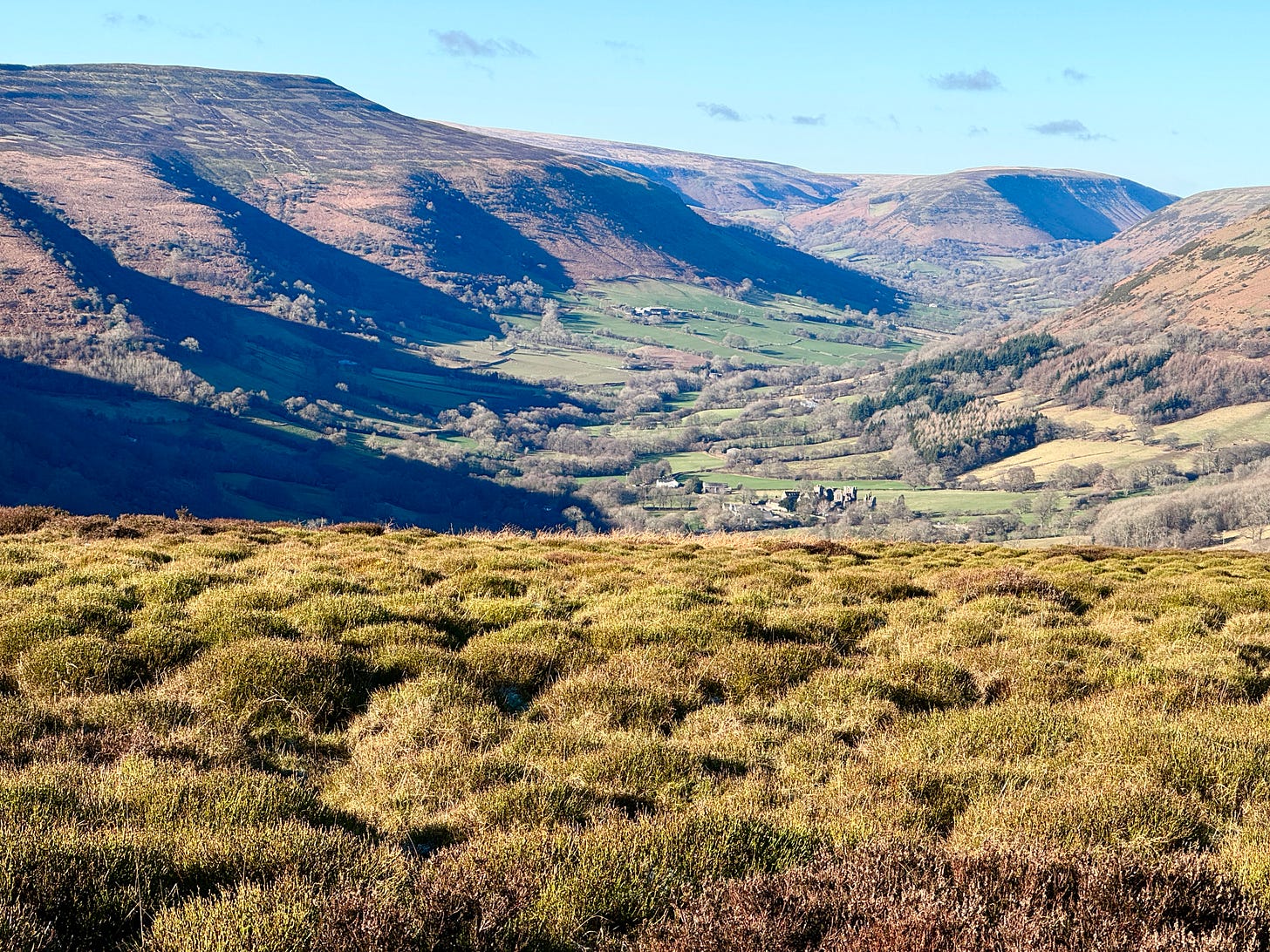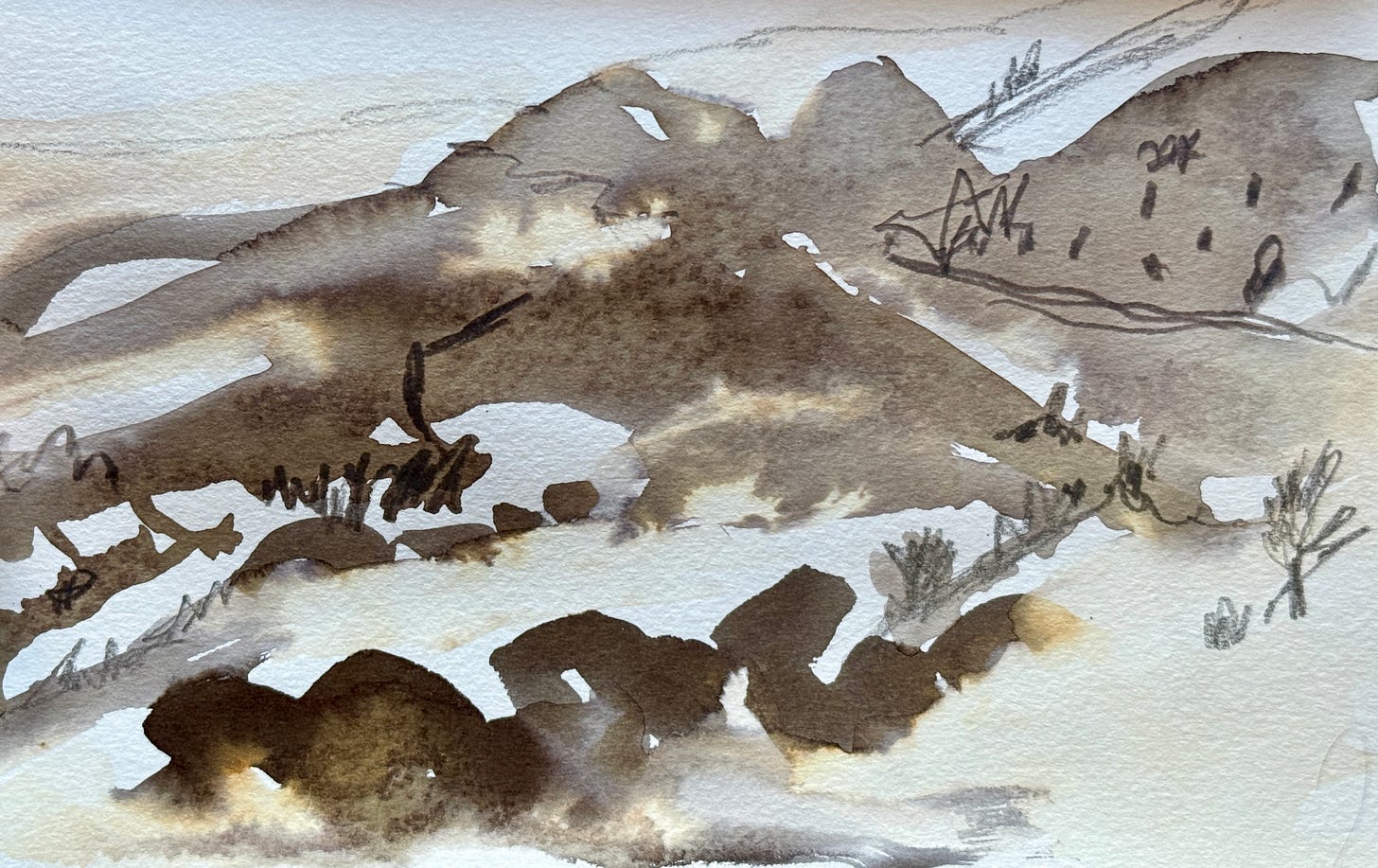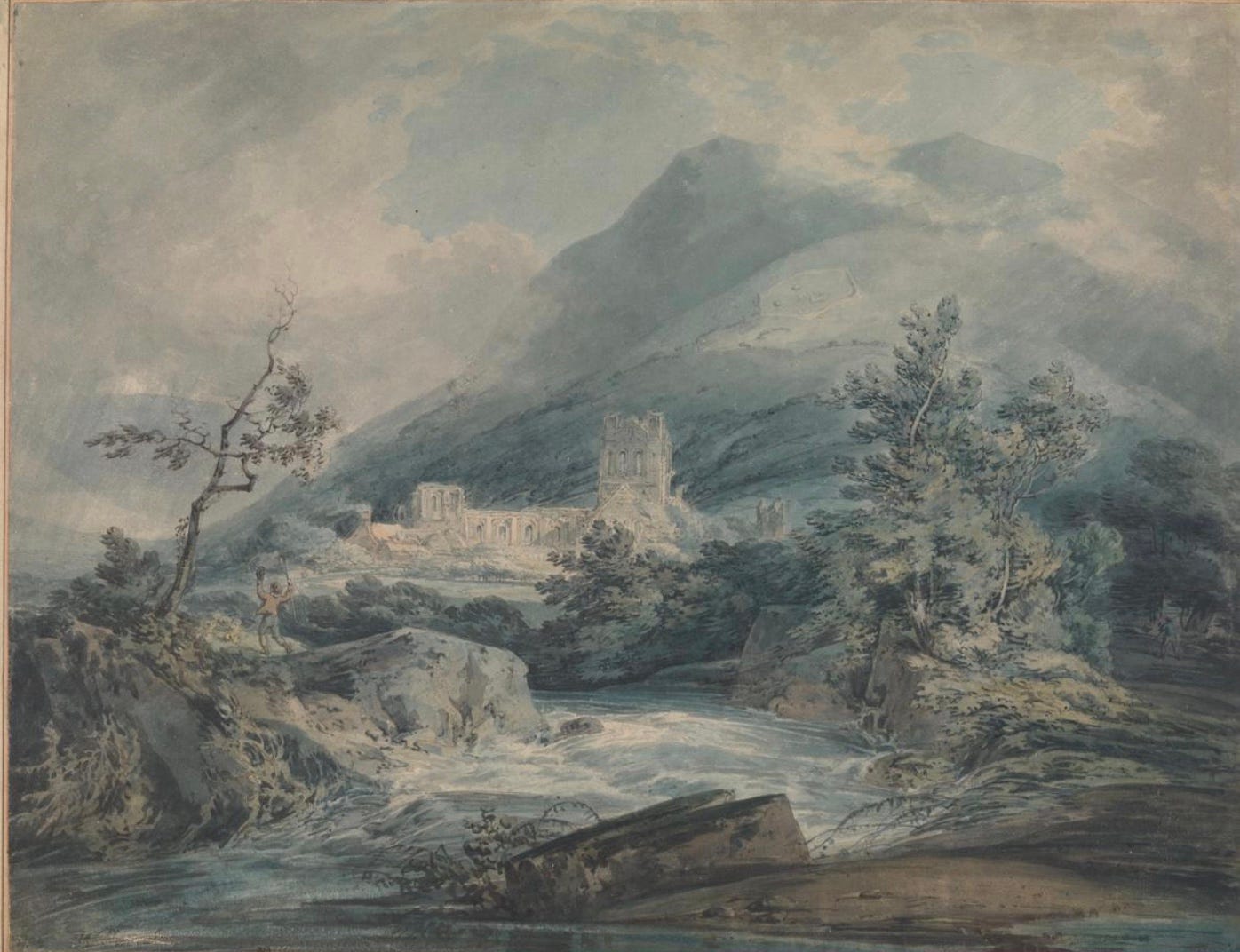Demo 10: plein air and inkiness
Filming a session in sub zero temperatures up on the Welsh border is all "part of the service" here at Kitchen Table Creatives.
On such a stunning day, I couldn’t let the opportunity go by so I packed up an artist’s rucksack with ink, a graphite stick and charcoal and a a couple of brushes. Working into my trusty A5 sketchbook I made a couple of loose expressive landscape sketches before heading off to take in a “kite’s-eye” view of Llanthony priory in the vale of Ewyas, Monmouthshire.
Oh and I lugged my awkward tripod and a wooden board as a base up the mountain too. Crazy huh? Over 8 miles covered, and it was an absolute pleasure to be out there, walking and sketching.
I hope you enjoy sharing the experience and feel a little bit inspired to get outside, however wintry, to have a go yourself.
Chilly and sublime
The exciting thing about sketching outside is the immediacy. It encourages a freedom and seems like you get a direct line to your own style.
This session includes a 14-minute demo about using brush and ink, along with a little bleach. As a bonus, I explore my brief research into Japanese brush and ink painting known as sumi-e, which is also about immediacy and bold decisiveness when it comes to mark making, along with discipline and skills that are humbling.
Finally, I tell you about JMW Turner’s visit to this area and his painting and etching of the priory.
Welcome to my new KTC members. Thank you for making the most of KTC: it’s so great to have you on board. Please do share with your friends if you think they’d benefit from the community here.
You can enjoy KTC “essay” posts for free. I only ask you to become a paid subscriber (£10 a month) to receive these fortnightly demos packed with ideas… Thanks so much; I love it that we’re making a community here!
I'm just an individual who doesn't feel that I need to have somebody qualify my work in any particular way. I'm working for me.
This demo is brought to you from the Welsh border. I walked up onto Hatterrall Ridge, which is the hill behind my studio and is well trodden as Offa’s Dyke path runs there.
I wanted to walk to a stunning vista which takes in the vale of Ewyas on the Welsh side and a view of the Norman-Gothic Llanthony priory. This historic site was a favourite of Georgian and Victorian touring artists; JMW Turner returned there several times to draw and make watercolours. More about that in the section below.
Don’t worry, we’re not going to paint the priory. We will focus on the fantastic shadows created by the low winter sunshine. And make the most of being outside, getting a different perspective, painting without any home comforts, quickly and without self consciousness.
Afterwards you can enjoy a quick and dirty foray into the world of Japanese sumi-e art.
Materials list
Fill a rucksack with:
a sketchbook or paper and a surface to paint on – you might like to try rice paper
optional charcoal and / or graphite stick
a little pot of ink, if you want to blend this with thin bleach you will need quink rather than Indian ink
water and / or thin bleach
a soft brush (avoid hard bristles) that can form a tip when dipped – traditional Chinese ink or Japanese sumi-e brushes are ideal but use what you have
Demo: plein air adventure
Get outside with your travelling studio kit. This can be a corner of your local park if you’re not rural or very mobile. As you start looking you will find interesting compositions.
Work quickly. Explore how the brush can give you a variety of lines and marks.
Back home try lots of repetitive strokes and shapes. Simply play and don’t make an image. Be bold and decisive about your marks. No hesitation or over-analysis.
Relish the immediacy of working both outside in challenging conditions or inside with no demands around composition or subject. Also find an “economy of line” for your brushstrokes – this is the genius of sumi-e, nothing should be overworked and the areas of unmarked surface are also key to the overall impression. Try loading your brush with diluted ink on the body and saturated ink at the tip.
Reflect on what you have made and what pleases your eye. Possibly make written notes about this and about developing your skills and confidence.
JMW Turner in south Wales
JMW Turner painted here in the Y Mynydd Du (the Black Mountains) and provided several dramatic versions of the historic site.
He first visited the area in the summer of 1792 and his sketches and watercolours exemplify his combining of “antiquarian” interests with landscape motifs.
This stormy distant view he executed of Llanthony priory (in the Tate collection) is dated later to 1794.
The work is hugely emotional. In the foreground. Aber Honddu (the Welsh border river) gushes over rocks suggesting waterfalls. In reality, this river is more benign even in winter. This scene that Turner sets, with this particular viewpoint, is geographically impossible and he renders Hatterrall ridge, from where I filmed our session, as a supersized mountain behind the priory.
With Turner you get to the truth through his representation of light and the elemental nature of landscape art. He favours a spiritual reality over topographical representation.
He is nothing if not mesmerising and evocative and he really has nailed the impact of the weather and light here in the Black Mountains with this painting of the priory.
Targeting tourists
You might think such a romantic, exaggerated vision of the priory would come from a risk-taking adventurous soul. Possibly, though Turner was also known for his organised and targeted art-tourism. He consulted contemporary travel literature and his network of peers to plan his travels, which he enjoyed throughout his life.
He carefully selected subjects so that they would be familiar to buyers and viewers, who were likely to have visited the sites themselves in the pursuit of experiencing romance and “the sublime”. In this sense, Turner was not pioneering but astute. Where he was pioneering – and brave – was in his virtuoso compositions and uninhibited approach to colour and unique style.
Wales, both south and north, featured in Turner’s early career. A visit to the Avon Gorge in Turner’s teens, where he’s believed to have first experienced the power of landscape over human emotion, was a precursor to his trips across the border taking in Chepstow and the Wye Valley, along with the Black Mountains.
Although he’s thought of as a visionary, a painterly poet and the ultimate visual romantic, he was in fact adept at marketing and rocketed to fame. He was quick to see a market and deliberately acquainted himself with etching as an art form so that his watercolours could be easily reproduced and published before he had even turned 20 years old.
In business
By July 1799 he had “orders for sixty drawings in hand” and in that year he became an Elected Associate of the Royal Academy and joined the Academy Club. By 1802, his wealth accruing, he presented a dozen silver dessert spoons to the Academy. In his first will and testament he allocated an impressive endowment to the RA: a professorship of landscape, a Turner Gold Medal for landscape painting and a college or charity for “decayed” English landscape artists.
He was capable of stunts as stories from his life show. Take the portrait of Turner by William Parrott. A contemporary explains that Parrott "caught Turner on Varnishing Day at the Royal Academy in 1846 in the act of touching up one of his submissions at the very last minute...," and suggests that he was doing so "not only because his fascination with his own technique urged him into continuous nervy improvements but also because he knew that the added brightness would make his contribution stand out."
Rollicking eye
With his father’s support he ran a home gallery open to a flow of important visitors. He was known to have worked relentlessly and without self-consciousness. “his ruddy face, his rollicking eye, and his continuous, although, except to himself, unintelligible jokes, gave him the appearance of one of that now wholly extinct race – a long-stage coachman,” remarked a critic.
We have further descriptions of him in laters years: "Short, stocky, dressed shabbily in black with a top hat still perched on his head, his untidy umbrella propped nonchalantly against a chair, Turner displays the unconcerned workaday concentration of the true genius, indifferent to outward appearances."
Next week I’ll be posting more food for [art] thought. Would love to hear from you if there’s a subject you want to explore together.






